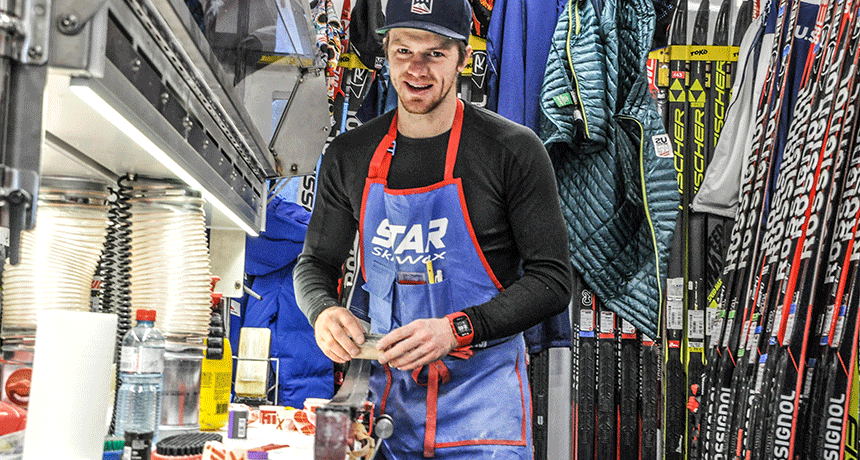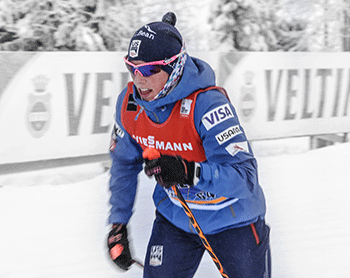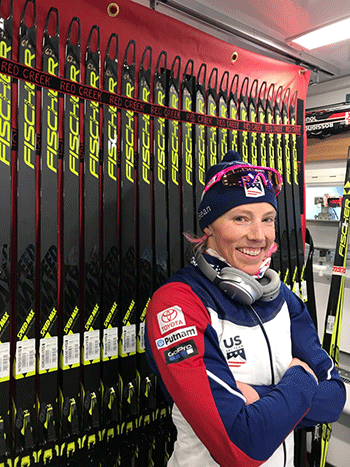Olympic ski racers use chemistry to enhance their performance
Waxes allow athletes to control how their skis glide under some conditions and grip in others

Andrew Morehouse waxes skis on site for the U.S. Olympic Nordic Ski Team. The recipe he uses will depend on snow conditions. Choosing the right wax may make all the difference in whether top athletes can go for the gold.
US Ski Team
By Eric Niiler
When the world’s top skiers face off this week at the Winter Olympics, they will be relying on years of training, mental preparation — and a good deal of chemistry. The chemistry of ski wax. The fastest skiers usually have the fastest skis. And speedy skis need their bottoms waxed with the right stuff.
All ski wax is not the same. The recipe an athlete uses must be tailored to match the feats they’ll attempt and the snow they’ll encounter. A wetter snow, for instance, will require a different wax than dry fluff. And downhill racers get a different recipe than cross-country skiers.
Chemicals in the wax help skis glide downhill. The wax does this by repelling water that forms as a ski slides across the snow. Cross-country skiers, in contrast, must go both uphill and downhill. Their ski wax, therefore, must help the athlete also grip the snow while climbing short hills during a race.
One type of wax makes skis slippery. Another makes it grip. A racer who uses the wrong formula risks lagging behind. This also can happen if the snow’s properties change during a race. Maybe it gets colder. Or starts snowing. It may even rain. Such weather changes can alter the surface of the snow in ways that can make it harder on racers.

That’s what happened to Kikkan Randall. She is a cross-country ski racer from Anchorage, Alaska. Beginning February 10, she’ll be competing in PyeongChang, South Korea, as part of the 2018 U.S. Winter Olympics team.
Randall remembers her skis picking up new-fallen snow in Finland earlier this season. They were like chunks of mud on a race.
“I had 3 inches [8 centimeters] of snow on the bottom of my skis and had to scrape it off and keep going,” she notes. “It was clear that I had the ability to have a better race. But my skis were making it impossible. I would have been better off with no wax.”
Randall attributes some wins that brought her to the Olympics to the waxes she used. It allowed her to glide faster than other racers on the downhill part of the course. The recipe she and others use is critical. Racers get only one chance to wax their skis before a race begins.
Long before a race, various waxes will be tested. Then, technicians and racers pick a mix that they think will best match the snow on race day. They rub and melt layers of the chemicals onto the bottom of each ski. Then they scrape and polish each layer to make it super-smooth. Sometimes they add a sticky wax called “klister” — or kick wax — to the part of the ski below the boot. This helps racers grip if and when they need to climb.
Choices, choices
Like gasoline and natural gas, wax contains one or more hydrocarbons. As their name suggests, these molecules are made from a chain of hydrogen and carbon atoms. The first layer of wax applied to the bottom of a ski is similar to the paraffin wax used in candles. It forms a bond with the bottom of the ski to keep out dirt and water.

The next layer contains fluorocarbons. These are molecules made from a mix of fluorine, hydrogen and carbon. These wax ingredients are designed for speed. They cut friction between the ski and the surface of the snow. (These chemicals are related to additives that manufacturers sometimes use to make rain gear repel water.)
Fluorocarbon waxes are softer than some other types. They may be used as fluids or as powders. For a two-minute downhill race, skiers want the slipperiest surface possible. They will need a different formula for a two-hour-long, cross-country event. Indeed, cross-country racers may apply six or more layers of wax to give a competitor control in moving up and down across a course.
Some fluorocarbon ski waxes also have extra hydrocarbons, such as acetone (ASS-eh-toan), benzene or toluene (TAAL-yu-een). These chemicals can be harmful if a person touches or inhales them a lot or over long periods. Yet they must be used repeatedly. After all, most of these chemicals will rub off a ski by the end of a race.
The chemistry of wax
Jeffrey Bates studies how ski waxes work. He is a materials scientist at University of Utah in Salt Lake City. He has invented a ski wax that can stick onto skis for the whole winter, not just for one race.
To do this, Bates pored over the bottom of plastic skis using a scanning electron microscope. It can display the surface of materials to a resolution of 1 nanometer (a billionth of a meter). For comparison, a human hair is 75,000 nanometers wide.
Under high magnification, the molecules on the bottom of the ski “looked like balls of spaghetti,” Bates says. Those spaghetti-like strands are polymers. Bates’ new liquid wax fills in the tiny nooks and crannies between the polymer strands. When exposed to sunlight, this coating chemically bonds to the ski. And that attachment is so strong it can last for months.
“We are not making this for racers,” Bates says. “We are making this for the regular person who goes to the slopes several times a year and doesn’t want to be bothered with waxing.” Why wouldn’t Olympians want it too? Its formula is set. It can’t be tweaked based on the particular conditions a competitor may need when going for the gold.
At the Olympics in South Korea, many teams will tweak their waxes’ chemistry in their bid to win a medal in ski racing. Each team will mix up its own secret recipe of waxes before the race starts.
“You try to do everything behind closed doors,” explains Andrew Morehouse. He’s a wax technician for the U.S. Olympic Nordic Ski Team. “I don’t know if there are spies, but it’s a natural thing to want to know what the other teams are waxing. Everyone keeps to themselves.”
For Randall and the other skiers, they hope that good chemistry will speed their path to the finish line.







